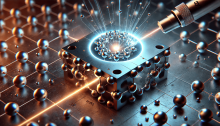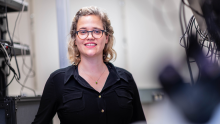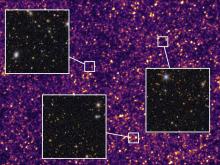An international team of researchers that includes UBC physicists has provided the first hints that muon neutrinos are able to transform into electron neutrinos when they travel over large distances.
The new results from the Japan-based Tokai-to-Kamioka (T2K) project indicate that muon neutrinos produced by a particle accelerator can transform into electron neutrinos as they travel across a long distance. The experiment uses a beam of muon neutrinos produced at the J-PARC accelerator laboratory in eastern Japan. These neutrinos are beamed from J-PARC through the Honshu island of Japan to the Super-Kamiokande neutrino detector 295 km away. A near neutrino detector at J-PARC measures the beam at its production point to allow a ‘before and after’ comparison for measurements at Super-Kamiokande.
Previous experiments have shown that muon neutrinos with similar energies can transform into other kinds of neutrinos while in transit due to a phenomenon known as "neutrino oscillation". However, the very low rate at which they turn into electron neutrinos is an outstanding puzzle in particle physics that is the focus of a worldwide effort.
"This is the first time that an experiment looking for this effect has found a result not consistent with zero," said T2K-Canada's spokesperson Scott Oser, associate professor of Physics at UBC and Canada Research Chair in Origins.
"These results are very intriguing but not yet conclusive. Really we need more data to confirm that this effect is real and not just a statistical fluke. We're looking forward to the resumption of data-taking once the process of earthquake recovery is complete."
Neutrinos, which come in three types, are subatomic particles similar to electrons but having no electric charge and masses millions of times smaller than electrons. They have the unique ability to pass through ordinary matter without stopping, allowing T2K's beam to actually pass through the main island of Japan on its way to the detector. It was once believed that neutrinos were massless, but results from Super-Kamiokande, Canada’s Sudbury Neutrino Observatory and other experiments have established that neutrinos have tiny masses and can oscillate from one type to another.
This phenomenon requires modifications to the Standard Model of particle physics, and a major global effort is underway to understand the different ways in which neutrinos can change type. Many theorists have suggested that differences in how neutrinos and antineutrinos oscillate might ultimately help to explain why our universe is made of matter and not anti-matter. A major puzzle is to understand why one type of neutrino, the muon neutrino, mostly avoids turning into an electron neutrino when it oscillates.
At simultaneous seminars at the host laboratories of KEK and the Institute of Cosmic Ray Research in Kashiwa, Japan today, T2K announced that, using all of the T2K data taken before the March 11 earthquake in Japan, they see six candidate electron neutrino events. If muon neutrinos didn't change into electron neutrinos, then T2K should have only seen 1.5 events on average. The chance of seeing six or more events when only 1.5 are expected is less than one percent, suggesting that some of the muon neutrinos are indeed turning into electron neutrinos, although at a very low rate.
The T2K collaboration consists of approximately 500 researchers from 12 countries and 59 institutions. Canada is one of the largest contributors to the experiment, with over forty scientists contributing from the University of British Columbia, TRIUMF, the University of Alberta, University of Victoria, the University of Regina, York University, and the University of Toronto.
UBC faculty members on the T2K experiment are Chris Hearty, Scott Oser and Hirohisa Tanaka. UBC was instrumental in building two of T2K’s near neutrino detectors and plays a key role in the data analysis.
The central piece of T2K's near detector and a key beam line monitor were built in Canada and are now integral parts of the experiment. T2K uses the concept, developed at TRIUMF in the 1990s, of an off-axis neutrino beam, in which the beam is aimed a few degrees away from the detectors in order to get a more favourable energy spectrum. T2K is supported in Canada by NSERC, National Research Council Canada, and the Canada Foundation for Innovation.
Musqueam First Nation land acknowledegement
We honour xwməθkwəy̓ əm (Musqueam) on whose ancestral, unceded territory UBC Vancouver is situated. UBC Science is committed to building meaningful relationships with Indigenous peoples so we can advance Reconciliation and ensure traditional ways of knowing enrich our teaching and research.
Learn more: Musqueam First Nation
Faculty of Science
Office of the Dean, Earth Sciences Building2178–2207 Main Mall
Vancouver, BC Canada
V6T 1Z4


